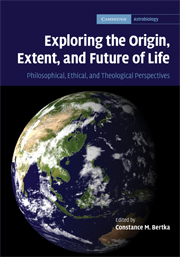 Exploring the Origin, Extent, and Future of Life
Exploring the Origin, Extent, and Future of Life from Part III - Future of life
Published online by Cambridge University Press: 29 December 2010
Introduction
There has been a lively discussion recently about the science and ethics of “terraforming” Mars. The high level of interest is a result of spacecraft discoveries about Mars combined with the realization that humans are effectively warming the Earth and wondering if they can, and should, do the same on Mars. I suggest that terraforming is more appropriately called planetary ecosynthesis, and in this chapter I review the scientific studies of planetary ecosynthesis and the environmental ethics associated with instigating such global change on another planet.
Mars today is a cold, dry, frozen desert world on which not even the most hardy of Earth life could survive. Temperatures average −60°C and the pressure averages 0.6 kPa, over one hundred times less than atmospheric pressure at the surface of the Earth. As a result of the low pressure, and secondarily the low temperature, water is not liquid on the surface of Mars at any location or season. Strong solar ultraviolet radiation reaches the surface of Mars to complete the deadly mix of hostile environmental conditions.
But Mars has not always been this harsh. There is compelling evidence that early in its history Mars had stable liquid water on its surface. Presumably this phase of liquid water was associated with a higher pressure and somewhat warmer atmosphere.
To save this book to your Kindle, first ensure [email protected] is added to your Approved Personal Document E-mail List under your Personal Document Settings on the Manage Your Content and Devices page of your Amazon account. Then enter the ‘name’ part of your Kindle email address below. Find out more about saving to your Kindle.
Note you can select to save to either the @free.kindle.com or @kindle.com variations. ‘@free.kindle.com’ emails are free but can only be saved to your device when it is connected to wi-fi. ‘@kindle.com’ emails can be delivered even when you are not connected to wi-fi, but note that service fees apply.
Find out more about the Kindle Personal Document Service.
To save content items to your account, please confirm that you agree to abide by our usage policies. If this is the first time you use this feature, you will be asked to authorise Cambridge Core to connect with your account. Find out more about saving content to Dropbox.
To save content items to your account, please confirm that you agree to abide by our usage policies. If this is the first time you use this feature, you will be asked to authorise Cambridge Core to connect with your account. Find out more about saving content to Google Drive.